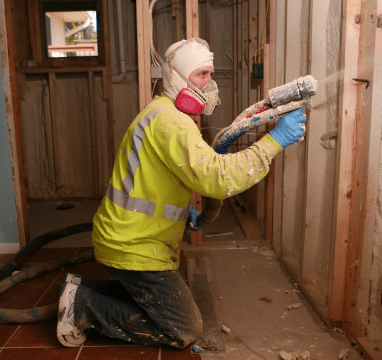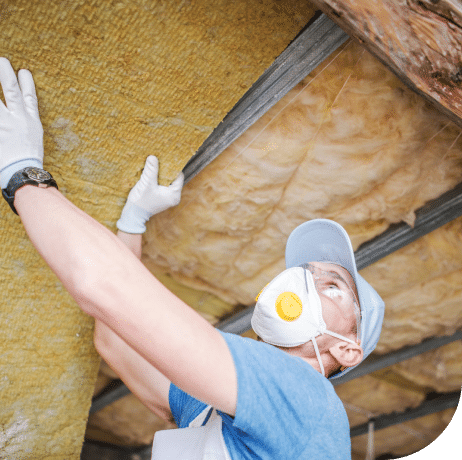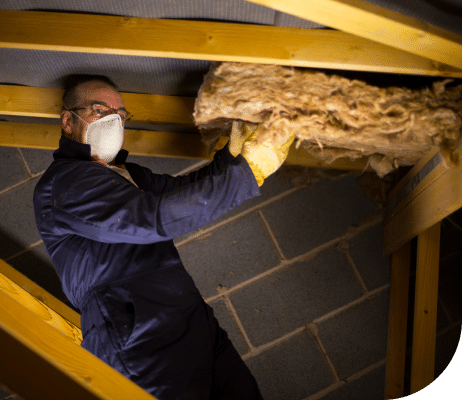Asbestos in Insulation
The insulating qualities of asbestos are among its most valuable properties. Asbestos insulation was used in virtually every building constructed between the 1930s and the late 1970s and in some homes constructed until 1990 and beyond. As a result, millions of workers and homeowners have contracted life-threatening asbestos-related illnesses.
Home » National Mesothelioma Law Firm » Asbestos Exposure » Asbestos in Consumer Products and Materials » Asbestos in Insulation
When was asbestos insulation produced and sold?
What does asbestos insulation look like?
Where is asbestos insulation found?
What to Do if You Suspect Insulation Contains Asbestos
When was asbestos insulation banned?
Occupations with Asbestos Exposure in Insulation
Asbestos was once nicknamed a “miracle mineral” before its harmful aspects were known. It seemed like the perfect substance to use in insulation. Insulation made from asbestos was lightweight, strong, fire-resistant, effective, and durable. It could insulate against both hot and cold temperatures, and it even provided soundproofing benefits.
Unfortunately, many of the qualities that make asbestos valuable for insulation also create unreasonable risks to human health. Its microscopic fibers are easily inhaled, and the human body is unable to expel them or break them down.
As a result, they remain in the body tissues, where they can cause inflammation that leads to mesothelioma, lung cancer, asbestosis, and other cancers decades after exposure to asbestos in insulation.
When was asbestos insulation produced and sold?
The company that eventually became Johns Manville was founded in 1858, and it marketed the first asbestos insulation products in the United States during the late 1800s and continued well into the 20th century. Johns Manville became a major supplier of asbestos insulation and building materials throughout the world.
The asbestos insulation industry grew exponentially. By the 1930s, nearly everyone used asbestos insulation in commercial and residential structures. The asbestos insulation industry knew by then that asbestos was harmful but actively colluded to conceal this information from the public.
The industry flourished until the late 1970s, when the harmful effects of asbestos on human health could no longer remain hidden. By this time, nearly every home, school building, public building, and commercial structure had been insulated with asbestos-containing materials. Millions of workers had been exposed, and the leaders of the insulation industry had become rich.
While sales of most asbestos insulation stopped by 1980, asbestos-contaminated vermiculite from the world’s largest vermiculite mine continued to be sold as insulation. Unbeknownst to the public and possibly to the owner, W.R. Grace, Libby vermiculite was contaminated with asbestos. This was not discovered until 1990, at which time the mine was shut down, and marketing activities ceased.
What does asbestos insulation look like?
Asbestos insulation was used to insulate buildings, wires, pipes, ductwork, boilers, stoves, and industrial equipment. According to Chessor Environmental Testing Ltd., there are five common types of insulation that contain asbestos.
Vermiculite
Vermiculite is a gravel-like loose-fill insulation that resembles small pebbles. It is sold under the brand name “Zonolite.” According to the Asbestos Institute, Zonolite brand vermiculite has the following physical characteristics:
- The vermiculite is silver-gold or gray-brown.
- The particles have an accordion-like texture.
- It lays flat against a joist cavity and remains firm.
Vermiculite is not always contaminated with asbestos. The vermiculite from the mine in Libby, Montana, is contaminated with tremolite asbestos. Tremolite asbestos is an amphibole family asbestiform, which is thin, sharp, and needle-like. Amphibole asbestos tends to embed more deeply into bodily tissues, resulting in a higher risk of asbestos disease.
Most commercial asbestos in the United States is the less dangerous chrysotile asbestos, the only type of asbestos in the serpentine family, named for the type of rock formation in which it occurs.
Spray Insulation
Spray-on asbestos insulation is common in industrial and commercial buildings. It is applied to large steel beams, ceilings, boilers, furnaces, and other heat-generating equipment. It is also used in residential ceilings and heating and cooling systems.
Spray-on asbestos insulation is one of the most dangerous types because it is friable. Friable asbestos is asbestos that is readily released into the environment when it is touched, as opposed to non-friable asbestos, which is encased in a material that cannot be disturbed by hand. Non-friable asbestos can become friable as a result of the destruction of the material in which it is encased.

Pipe Wrapping
Pipe wrapping is generally a pre-formed material that occurs as one of the following types:
- Asbestos air-cell insulation
- Asbestos wool insulation
Asbestos air-cell insulation looks like corrugated cardboard and is especially dangerous because the cardboard wears down over time, making the asbestos friable. Found around pipes and ductwork, it is most often seen in basements, attics, and utility rooms.
Asbestos pipe wrap may also occur as an asbestos-containing adhesive or a material that resembles white paper.
Loose-Fill Insulation
Loose-fill insulation is a fluffy, lumpy insulation that is blown through tubes onto attic floors, or it is poured. It is easily disturbed by the slightest breeze, which makes it a dangerous friable form of asbestos.
Block Insulation
Block insulation consists of solid blocks of nearly 100 percent asbestos that were secured to the inside of the walls of a building. Due to the high asbestos concentration, they are extremely dangerous if damaged.
Insulation That Likely Does Not Contain Asbestos
The following forms of insulation do not contain asbestos but are instead likely comprised of rock wool, fiberglass, or cellulose:
- Blanket insulation, including batt and roll insulation
- Cellulose insulation – Comprised of different types of recycled paper and looks clumpy, soft, and gray without a shine
- Rock wool insulation – Fibrous, soft, and cottony insulation that is gray, white, or cream-colored, and may be installed as loose fill or batts
- Loose-fill fiberglass insulation – Fluffy, white insulation that resembles cotton candy and has a slight shine
It can be difficult to differentiate between asbestos insulation and other types. The only definitive way to know whether the insulation is safe is to have it professionally tested. If your house was built before 1980, you should assume it contains asbestos until testing proves otherwise.
Where is asbestos insulation found?
Asbestos insulation products may be found in commercial buildings, residential buildings, single-family homes, and schools.
Commercial and Industrial Asbestos Insulation
In addition to insulating the walls, ceilings, and floors, insulation may also be used around products that generate extreme temperatures or need protection from moisture, chemicals, electrical current, and high temperatures. This includes the following industrial equipment:
- Boilers and other furnaces
- High-pressure pipes, valves, and ducts
- Engines
- Turbines
- Kilns
- Stoves
- Electric motors
- Electrical wiring
Asbestos Insulation in the Home
Asbestos insulation may be found in the walls, ceilings, and floors of residences. It is also commonly used around wood stoves, furnaces, heating elements, hot water heaters, pipes, and heating and cooling ductwork. It is sometimes seen in electrical wiring in residences, although this is more common in commercial settings.
An Australian study published in the Lancet found that men exposed to residential asbestos had a risk of developing mesothelioma that was two-and-a-half times greater than in men not exposed. However, there was no increase in women.
Researchers surmised that the unchanged mesothelioma incidence in women could be attributed to men being more likely to spend time in areas where asbestos insulation is present.
However, the study found a higher incidence of colorectal cancer in women but only a statistically insignificant rise in men. Men exposed to residential asbestos had a higher incidence of prostate cancer.
What to do if you suspect insulation contains asbestos
If you suspect you have identified asbestos insulation in your home or workplace, do not attempt to remove it. Doing so can release a large number of asbestos fibers that can quickly travel throughout your home or office. The safest course of action is to hire a licensed asbestos contractor to test the insulation and perform airborne asbestos testing.
If your building was constructed before 1990, and you are unaware of whether the insulation has been updated, assume that it has not. If the insulation is encapsulated inside the walls, ceiling, or flooring, it is generally not considered a hazard. However, it only takes one slightly worn or damaged area to release asbestos. Professional testing is always the safest course.

When was asbestos insulation banned?
Shockingly, asbestos is not completely banned in the United States, and the U.S. Environmental Protection Agency (EPA) allows some building insulation to contain up to one percent asbestos. However, the EPA has banned most uses of asbestos in insulation:
- 1973: The EPA banned spray-on asbestos insulation for fireproofing and fire-insulating purposes.
- 1975: The EPA banned asbestos pipe insulation and asbestos block insulation, impacting boilers and hot water tanks.
- 1989: The EPA banned new uses of asbestos.
- 1990: The EPA banned spray-on asbestos insulation in buildings, structures, pipes, and conduits except under specific conditions.
- 2019: The EPA issued a final rule banning companies from reintroducing discontinued asbestos without EPA review, approval, and assignment of restrictions, including pipeline wrap and building insulation.
Occupations with Asbestos Exposure in Insulation
The following workers have experienced occupational asbestos exposure through the manufacture and processing of asbestos-containing insulation materials, or as a result of working with the materials on a job site.
- Boiler workers
- Building inspectors
- Carpenters
- Construction workers
- Demolition workers
- Drywallers
- Electricians
- Firefighters
- Furnace workers
- Hod carriers
- Insulators
- Laborers
- Libby vermiculite exfoliation plant workers
- Maintenance workers
- Millwrights
- Operating engineers
- Pipefitters
- Plasterers
- Plumbers
- Shipyard workers
- Steamfitters
Many of these workers are still exposed to asbestos in insulation today while working in older buildings and industrial sites. It is not necessary to work directly with insulation in order to be exposed. Workers can be exposed to asbestos by working in an environment where insulation is being installed or removed.
Occupations like electricians and drywallers may be required to handle asbestos-tainted insulation in order to complete their duties. Electricians can also be exposed when cutting, splicing, or stripping older electrical wiring. Plumbers may be exposed to asbestos when having to cut insulated pipes. Firefighters can be exposed when entering burning buildings.
Insulation Companies That Exposed People to Asbestos
The use of asbestos insulation was so widespread that each insulation company exposed thousands or even millions of people to asbestos and became liable when they contracted related illnesses. Most of these companies have declared bankruptcy under Chapter 11. Section 524(g) of Chapter 11 requires these companies to establish asbestos trust funds for the benefit of their victims.
Most of the companies that have not declared bankruptcy were distributors of multiple products alongside insulation, or the manufacture and sale of insulation products were not their primary business. The solvent asbestos companies that may be liable for asbestos exposure in insulation include the following:
- Ace Hardware Corporation
- BMI Refractory Services, Inc.
- Bechtel Corporation
- Mundet Cork Company, acquired by Crown Cork & Seal Company, Inc.
- Owens-Illinois, Inc.
- Sears, Roebuck & Company
- Tellepsen Corp
- The Cleveland Gypsum Company, also known as Ceecorp and formerly The Cleveland Builders Supply Company
- The Sherwin-Williams Company
- Thermwell Products Company
- Universal Refractories

The following companies have established asbestos trust funds as a result of a Chapter 11 bankruptcy reorganization:
- Armstrong Contracting and Supply Company
- Babcock & Wilcox
- Bondex
- Brauer Supply Company
- Celotex
- Christy Refractories
- Eagle-Picher Industries, LLC
- Fuller-Austin
- Garlock Sealing Technologies
- Geo. V. Hamilton, Inc.
- G-I Holdings, Inc.
- J.T. Thorpe
- Johns Manville
- Leslie Controls
- National Gypsum Company
- North American Refractories Company – Industrial
- Owens-Corning/Fibreboard
- Pittsburgh Corning Corporation
- Plant Insulation
- Plibrico
- Porter Hayden Company
- Quigley Company, Inc.
- Rock Wool Manufacturing Company
- Shook & Fletcher
- State Insulation Corporation
- Thorpe Insulation
- United Gilsonite Laboratories
- W.R. Grace
Can I sue the insulation companies for asbestos exposure?
If you have contracted mesothelioma, asbestosis, lung cancer, or another cancer after being exposed to asbestos in insulation, you may qualify to file a mesothelioma lawsuit, trust fund claim, or a workers’ compensation claim. In some cases, you may qualify for multiple claims.
Our mesothelioma attorneys at The Lanier Law Firm have seen firsthand the devastation asbestos-related illnesses cause, and we provide fearless, skillful representation. With more than 30 years of experience handling mesothelioma claims, we know what it takes to successfully stand up to large asbestos companies.
Our law firm is one of the most feared law firms in the nation because we consistently win historical settlements and verdicts on behalf of our deserving clients. Contact us today to schedule a free consultation.
By submitting this form, you agree to our terms & conditions. Please read the full disclaimer



